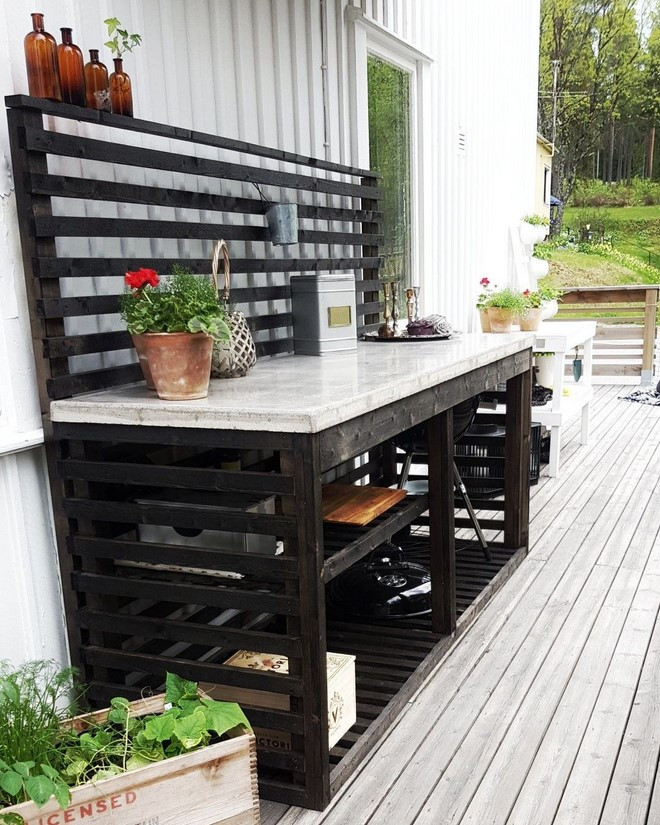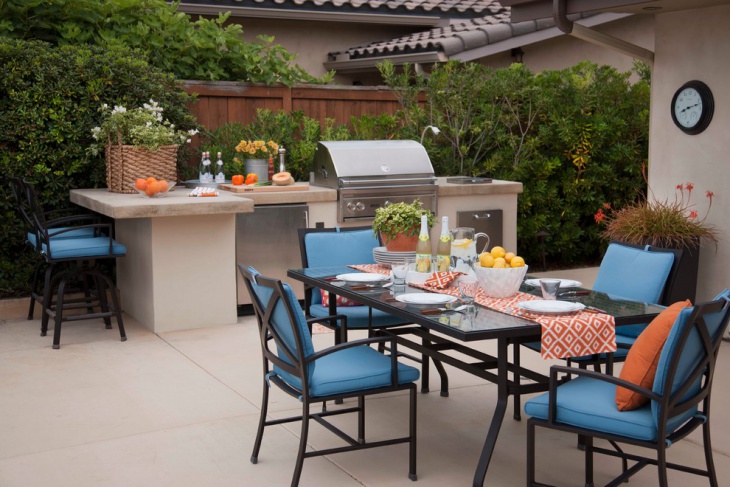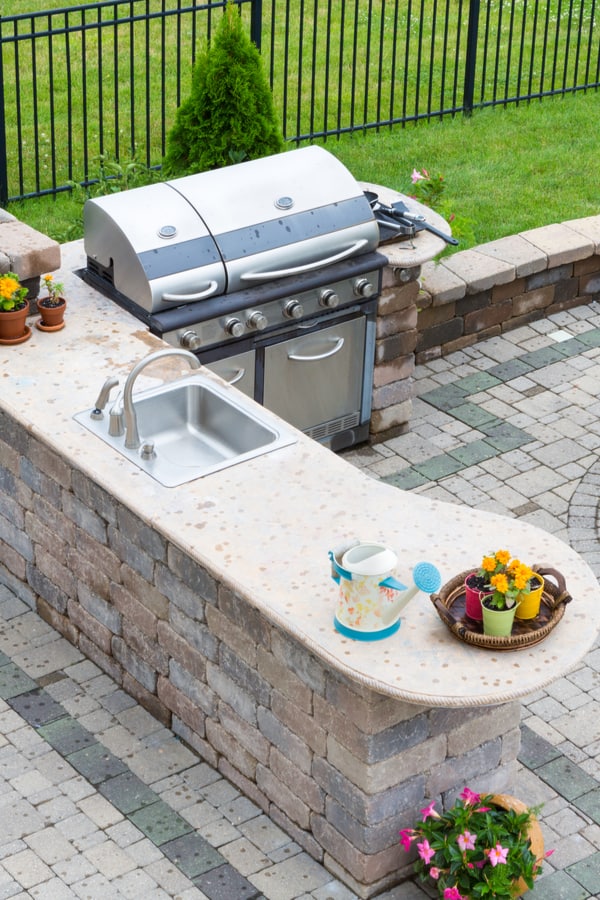Building an outdoor kitchen island can be an exciting and rewarding project that adds both functionality and value to your outdoor living space. When I first embarked on the journey of creating my outdoor kitchen island, I quickly realized that it requires careful planning, thoughtful design, and the right materials to ensure long-lasting durability. The project involves more than just laying a few bricks and placing a countertop; it includes plumbing, electrical work, and often gas connections, making it essential to approach with a comprehensive plan.
The first step in building an outdoor kitchen island is deciding on the location. This decision should be based on several factors, including accessibility, proximity to the house, and exposure to the elements. I chose a spot near my patio that provided easy access to both the indoor kitchen and the dining area, making it convenient for serving and entertaining guests. It’s also important to consider wind direction to avoid smoke from a grill blowing into seating areas or the house. Make sure there’s enough space around the island for movement and furniture, creating a comfortable environment for cooking and socializing.

After selecting the location, the next step is determining the layout and size of the island. The design should reflect your cooking style and how you plan to use the outdoor kitchen. For instance, I wanted an island that accommodated both a grill and a small sink, so I designed it with a spacious countertop for food preparation. If you’re planning on adding appliances like a refrigerator or built-in grill, make sure to allocate sufficient space. Keep in mind that the layout should be both functional and aesthetically pleasing, ensuring a natural flow from the cooking area to seating and dining spaces.
Once the design is finalized, it’s time to choose the construction materials. Outdoor kitchen islands must withstand various weather conditions, so it’s essential to select materials that are both durable and weather-resistant. I opted for a steel frame with cement board and stone veneer for the exterior, creating a sturdy base that could support the heavy countertop and appliances. For the countertop, I selected granite due to its resistance to heat and staining, making it a practical choice for an outdoor environment. However, materials like concrete or tile can also be excellent options, depending on your style and budget.

In addition to materials, you’ll also need to decide on the type of appliances you want to incorporate into the kitchen island. The most common appliance is a built-in grill, but you might also consider adding features like a refrigerator, sink, or even a pizza oven. I went with a grill and a compact refrigerator for storing beverages, which proved to be a great addition for outdoor entertaining. When selecting appliances, ensure they are designed for outdoor use and are resistant to the elements. Stainless steel appliances are a popular choice due to their durability and ease of maintenance.
One of the most crucial aspects of building an outdoor kitchen island is ensuring proper ventilation and safety measures. Cooking appliances, especially grills, generate heat and smoke, which need to be properly vented to avoid accidents and ensure a comfortable cooking environment. I installed a vent hood above the grill to direct smoke away from the seating area and prevent grease buildup. Additionally, if you’re installing a gas grill, you’ll need to work with a licensed professional to ensure safe gas connections and to avoid leaks. Electrical outlets should also be placed at safe distances from water sources, and all wiring should be GFCI-protected.

Once the structural aspects and appliances are in place, it’s time to think about the finishing touches, such as lighting and seating. Adequate lighting is essential for evening cooking and entertaining. I added overhead LED lights above the countertop and under-cabinet lighting for a soft, ambient glow. If you plan on using the outdoor kitchen in the evenings, lighting not only adds to the atmosphere but also increases safety. In terms of seating, I opted for bar stools around the island, creating a casual and inviting area for guests to sit while I cook. Comfortable seating is key to making the space functional for both cooking and socializing.
Waterproofing and drainage are critical when building an outdoor kitchen island. Even though the materials used are typically weather-resistant, I found that adding a layer of waterproofing to the countertops and joints helped prolong the life of the kitchen. Installing proper drainage, especially if you have a sink, ensures that water doesn’t pool around the base of the island, which could lead to structural damage over time. You’ll need to consider the direction of water runoff and potentially install drainage pipes or slope the countertops slightly to allow for proper drainage.
While planning my outdoor kitchen island, I realized that storage was another essential feature. Outdoor kitchen islands often lack the cabinetry found in indoor kitchens, so planning for adequate storage is crucial. I included built-in stainless steel cabinets under the countertop, which provided space for utensils, cookware, and cleaning supplies. Having storage in the island minimizes trips back and forth to the indoor kitchen, allowing you to focus on cooking and entertaining without interruption.

Incorporating weather protection for appliances and the island itself is also important. Covers for grills and other appliances can extend their lifespan and prevent rusting. Additionally, if you live in an area with extreme weather conditions, consider adding an overhang or pergola above the kitchen island to protect it from direct sunlight and rain. I installed a pergola with a retractable shade, protecting from the elements while also allowing me to enjoy the open air.
When it came to the plumbing, having a sink was a non-negotiable feature for me, so I ensured that the outdoor kitchen island was connected to the main water line. Installing a sink in an outdoor kitchen makes meal prep and cleanup much easier. However, it’s essential to have proper drainage and winterize the plumbing if you live in a colder climate to prevent pipes from freezing. Consulting with a plumber is advised, especially if you’re not familiar with plumbing installation.
The electrical work involved in building an outdoor kitchen island can’t be overlooked. Most outdoor kitchens will require electrical outlets for appliances, lighting, and possibly even entertainment systems like outdoor speakers or TVs. I had an electrician install multiple GFCI outlets along the island and wired the lighting to a switch near the patio door for easy access. It’s crucial to ensure all electrical work is up to code and weatherproofed, as outdoor conditions can be harsh on electrical components.

After completing the structural and functional elements of the outdoor kitchen island, the finishing details made all the difference. I added decorative elements like potted plants, outdoor rugs, and hanging lanterns to create a cozy, inviting atmosphere. Outdoor kitchens are as much about aesthetics as they are about function, and personalizing the space with decor that reflects your style can enhance the overall experience. Since my space had a natural stone veneer, I chose rustic, earth-toned decor to complement the materials and create a cohesive look.
Maintaining the outdoor kitchen island is relatively straightforward, but regular cleaning and inspections are necessary to ensure longevity. I wipe down the countertops after each use, clean the grill regularly, and inspect the plumbing and electrical systems at least once a year. By keeping up with maintenance, I’ve found that the outdoor kitchen remains in excellent condition, providing a reliable space for outdoor cooking and entertaining for years to come.
Overall, building an outdoor kitchen island transformed my backyard into a functional, entertaining space. It allows me to enjoy cooking outdoors while spending time with family and friends, creating a more social and engaging experience. While the project required a lot of planning and effort, the result was well worth it. Whether you’re a casual griller or a serious chef, an outdoor kitchen island can enhance your outdoor living space and add significant value to your home.

Common Mistakes to Avoid
One common mistake when building an outdoor kitchen island is neglecting proper ventilation. Without adequate ventilation, smoke and heat from the grill can become overwhelming and dangerous. Make sure to include a vent hood or open design to allow airflow.
Another mistake is choosing the wrong materials. Indoor materials like untreated wood or non-weatherproof tiles can quickly deteriorate in an outdoor environment. Always select materials that are resistant to water, heat, and weather to ensure longevity.
Improper electrical work can lead to serious safety hazards. Outdoor kitchens require weatherproof outlets and GFCI protection. Hiring a licensed electrician is essential to ensure all electrical components are safely installed and up to code.
Failing to account for drainage is another common issue. Outdoor kitchen islands need proper water drainage, especially if they include a sink. Without drainage, water can pool and cause damage to the structure over time.
Finally, skimping on storage is a mistake many people make. Having sufficient storage built into the island is crucial for functionality. Without it, you’ll find yourself constantly going back to the indoor kitchen for utensils and supplies.

How much does it cost to build an outdoor kitchen island?
The cost of building an outdoor kitchen island varies greatly depending on the size, materials, and appliances you choose. A basic setup with a grill and countertop can start at around $3,000, while a more elaborate design with high-end materials and appliances can exceed $10,000. It’s essential to set a budget before starting and plan accordingly.
What materials are best for outdoor kitchen islands?
Materials like stainless steel, stone, and concrete are ideal for outdoor kitchen islands because they are weather-resistant and durable. For countertops, granite and concrete are popular choices due to their heat resistance and ability to withstand outdoor conditions. Avoid materials like untreated wood or indoor tile, as they can quickly deteriorate in an outdoor setting.
Do I need a building permit for an outdoor kitchen island?
In most cases, you will need a building permit, especially if your outdoor kitchen island includes gas lines, plumbing, or electrical work. It’s important to check with your local municipality to determine the specific requirements in your area. Hiring licensed professionals for plumbing and electrical installations can also help ensure that your project meets local codes.

Can I build an outdoor kitchen island myself?
If you have experience with construction, plumbing, and electrical work, building an outdoor kitchen island can be a DIY project. However, if you are not confident in these areas, it’s best to hire professionals. There are many aspects to consider, such as gas and water lines, ventilation, and electrical wiring, all of which must be installed correctly to ensure safety and functionality. While doing it yourself may save money upfront, improper installation can lead to costly repairs and potential safety hazards in the future.
How can I protect my outdoor kitchen island from the elements?
Protecting your outdoor kitchen island from weather damage is crucial for ensuring its longevity. You can add a pergola or an awning to shield the area from direct sunlight and rain. Additionally, using weather-resistant materials for countertops and cabinets, such as stainless steel or stone, will help protect against rust, moisture, and UV rays. I also recommend investing in durable covers for appliances like grills or refrigerators when they’re not in use. Sealing the countertops and applying weatherproofing treatments can further extend the life of the materials.
How do I maintain my outdoor kitchen island?
Regular maintenance of an outdoor kitchen island includes cleaning the countertops, appliances, and cabinets. After each use, wipe down the surfaces to remove grease and food residue, especially on the grill and cooking areas. For stone countertops, resealing them annually can help protect against staining and weather damage. Check the plumbing, gas lines, and electrical connections at least once a year to ensure they are functioning properly. Additionally, covering your outdoor kitchen during the off-season or harsh weather conditions will help prolong the life of the appliances and materials. Proper maintenance ensures your outdoor kitchen island remains in top shape for years to come.

Related Posts:
- Arhaus Kitchen Island
- Walnut Kitchen Island With Breakfast Bar
- Kitchen Island With Overhang For Seating
- Lazy Susan Kitchen Island
- Piano Kitchen Island
- Portable Kitchen Island With Chairs
- Kitchen Island Sink Backsplash
- Kitchen Island 3d Model
- Portable Kitchen Island Bench Melbourne
- Creative Kitchen Island Ideas